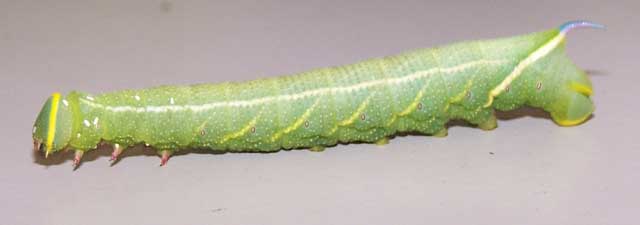
Smerinthus cerisyi (more likely Smerinthus ophthalmica), Siletz, Lincoln County, Oregon,
September 30, 2006, courtesy of Marita and Monteen Nash.

Smerinthus cerisyi (more likely Smerinthus ophthalmica), Siletz, Lincoln County, Oregon,
September 30, 2006, courtesy of Marita and Monteen Nash.
I wrote back: Monteen,
I have some good news and some bad news.
The good news is I can confirm your id as Smerinthus cerisyi, revised to S. ophthalmica.
The bad news is the oblong white shapes concentrated near the head
and thorax are the eggs of a parasitic wasp or fly.
If the parasite larvae have already hatched, they will have bored
underneath the egg capsule through the skin of the caterpillar
into its body. They then begin eating the fatty tissues and internal
organs of the caterpillar which is hopelessly doomed.
It may still pupate, but more likely it will keep feeding until the
parasite larvae are mature and leave the body by boring back out
through the skin and forming small white cocoons on the caterpillar's
back. Gross!
See the picture of Manduca rustica larva at bottom of the
following page:
http://www.silkmoths.bizland.com/mrustrus.htm
It is a bug eat bug out there!
There is a very slight possibility (remote) that you and only you can
still rescue the caterpillar.
You must take a sharp needle or pin and carefully pick off the wasp
eggs without poking the caterpillar.
Based on the number of eggs, you have extensive surgery to perform.
If there is no little black mark under the eggs, indicating larvae
have already hatched and burrowed into the body, then the caterpillar
can be rescued.
If the parasite larvae have already borrowed in, it is almost
assuredly too late.
Maybe there is one chance in a thousand that parasite larvae have
hatched only in last day or so and are close to skin surface.
If that is the case, treatment of little black dots with a swab of
mercurichrome (sp?) or iodine, may kill the parasites before they
have done irreparable damage.
An interesting feature of the parasites is that they secrete a growth
hormone that keeps the moth caterpillar feeding until they
have matured. Then the moth caterpillar dies.
The adult parasitic wasps or flies are harmless to humans.
I do not think anyone will fault you if you do not try to rescue!
However, the effort, especially if it is successful, will probably be
etched in your daughter's mind for the rest of her life.
Good luck either way. It is a bug eat bug world out there."
Please tell your Marita that I say you are being
extremely brave and caring to even attempt the surgery.
You might try putting it in the refrigerator for about twnety minutes
in a tupperware type dish with lid on tight to cool it down and slow
metabolism, but it doesn't understand you are only trying to help.
You are too late if you see the little black entry hole under the egg. Otherwise you may stil be okay. Ask Marita to say a prayer.
Your efforts and the prayer are all the tiny bug has going for it,
and maybe Marita found it in time.
Best of luck.
A WO" after the species name indicates that I have no confirmed reports of this species in Lincoln County, but I (William Oehlke) expect that this moth is present.
Please help me develop this list with improved, documented accuracy by sending sightings (species, date, location), preferably with an image, via email to Bill Oehlke.
Sphinginae subfamily
Smerinthini Tribe:
Macroglossinae subfamilyDilophonotini Tribe:
Macroglossini Tribe:
|
This page is brought to you by Bill Oehlke and the WLSS. Pages are on space rented from Bizland. If you would like to become a "Patron of the Sphingidae Site", contact Bill.
Please send sightings/images to Bill. I will do my best to respond to requests for identification help.
Enjoy some of nature's wonderments: Saturniidae cocoons. Cocoons of the giant silkmoths may be purchased in the fall and winter. Big and beautiful giant silk moths will emerge in spring/summer. Read Actias luna rearing article. Additional online help available.